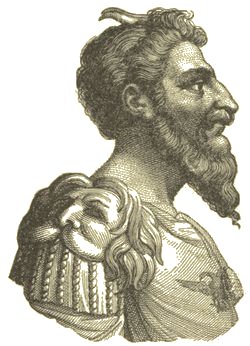Attila the Hun, often called the "Scourge of God," was one of the most feared and formidable leaders of the Huns, a nomadic tribe from Central Asia. Born around 406 AD, Attila rose to power alongside his brother Bleda after the death of their uncle, Rugila, around 434 AD. After consolidating power by eliminating his brother, Attila became the sole ruler of the Huns and embarked on a series of aggressive military campaigns that left a significant mark on the history of Europe.
 Under Attila's leadership, the Hunnic Empire expanded dramatically, stretching from the Ural River to the Rhine River and from the Danube River to the Baltic Sea. Attila's campaigns against the Eastern Roman Empire resulted in the plundering of many cities and forced the Romans to pay substantial tributes to avoid further devastation. His invasion of the Balkans and his assault on the city of Constantinople demonstrated his military prowess and strategic acumen.
Under Attila's leadership, the Hunnic Empire expanded dramatically, stretching from the Ural River to the Rhine River and from the Danube River to the Baltic Sea. Attila's campaigns against the Eastern Roman Empire resulted in the plundering of many cities and forced the Romans to pay substantial tributes to avoid further devastation. His invasion of the Balkans and his assault on the city of Constantinople demonstrated his military prowess and strategic acumen.
In 451 AD, Attila turned his attention to the Western Roman Empire, leading a massive invasion into Gaul (modern-day France). This campaign culminated in the Battle of the Catalaunian Plains, also known as the Battle of Chalons, where Attila's forces were confronted by a coalition of Roman and Visigothic troops led by the Roman general Flavius Aetius. The battle was one of the largest of its time and resulted in a significant, though indecisive, engagement that halted Attila's advance into Western Europe.
Attila's reign came to an abrupt end in 453 AD when he died under mysterious circumstances, traditionally believed to be a severe nosebleed on his wedding night. After his death, the Hunnic Empire quickly fragmented, losing its dominant position in Europe.
Attila's legacy is one of terror and conquest, and he remains a symbol of barbarian invaders in Western historical tradition. His life and campaigns had a lasting impact on the late Roman Empire and the shape of medieval Europe, illustrating the powerful influence of the Huns during his reign.
|

 Under Attila's leadership, the Hunnic Empire expanded dramatically, stretching from the Ural River to the Rhine River and from the Danube River to the Baltic Sea. Attila's campaigns against the Eastern Roman Empire resulted in the plundering of many cities and forced the Romans to pay substantial tributes to avoid further devastation. His invasion of the Balkans and his assault on the city of Constantinople demonstrated his military prowess and strategic acumen.
Under Attila's leadership, the Hunnic Empire expanded dramatically, stretching from the Ural River to the Rhine River and from the Danube River to the Baltic Sea. Attila's campaigns against the Eastern Roman Empire resulted in the plundering of many cities and forced the Romans to pay substantial tributes to avoid further devastation. His invasion of the Balkans and his assault on the city of Constantinople demonstrated his military prowess and strategic acumen.









